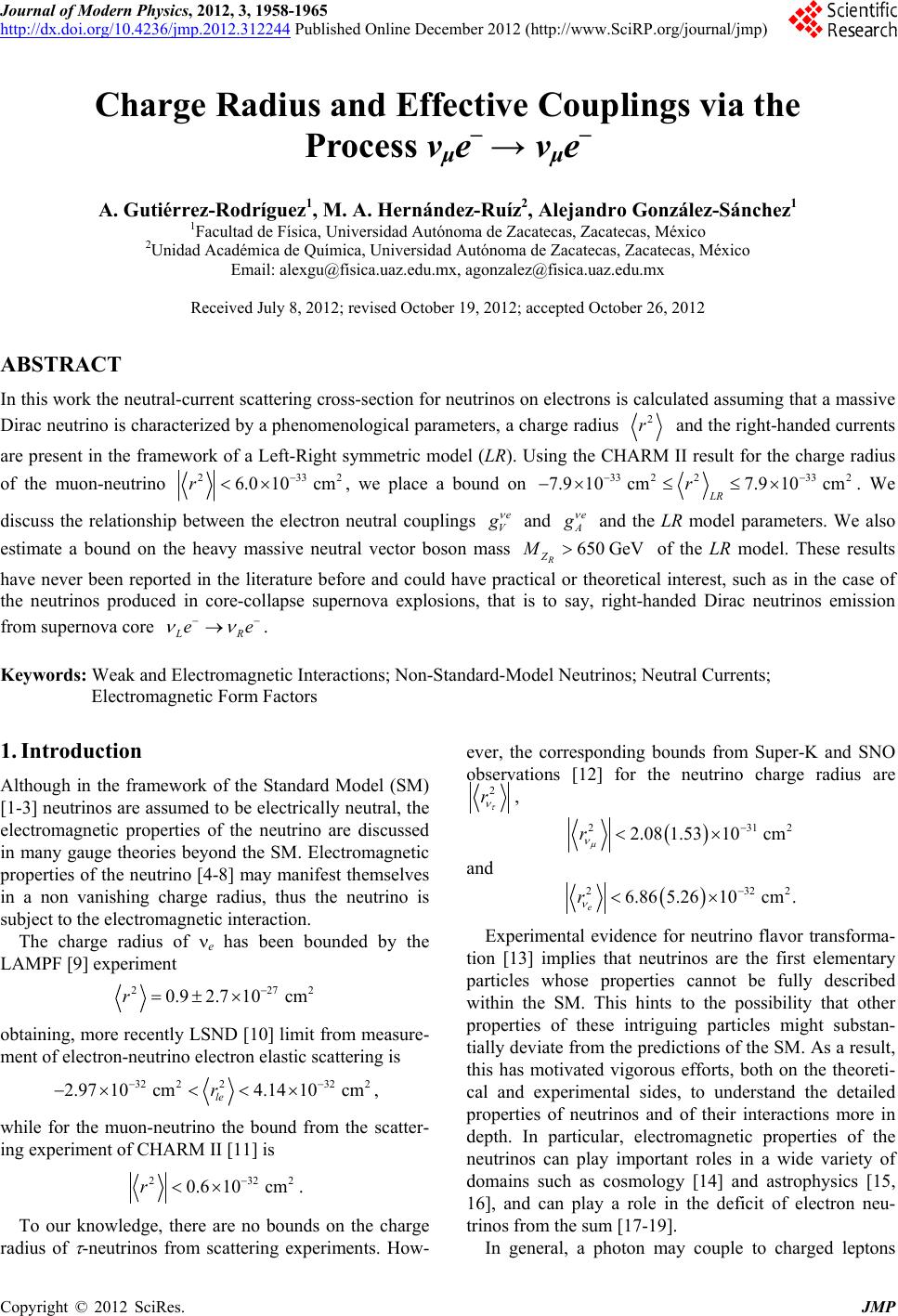 Journal of Modern Physics, 2012, 3, 1958-1965 http://dx.doi.org/10.4236/jmp.2012.312244 Published Online December 2012 (http://www.SciRP.org/journal/jmp) Charge Radius and Effective Couplings via the Process vμe– → vμe– A. Gutiérrez-Rodríguez1, M. A. Hernández-Ruíz2, Alejandro González-Sánchez1 1Facultad de Física, Universidad Autónoma de Zacatecas, Zacatecas, México 2Unidad Académica de Química, Universidad Autónoma de Zacatecas, Zacatecas, México Email: alexgu@física.uaz.edu.mx, agonzalez@fisica.uaz.edu.mx Received July 8, 2012; revised October 19, 2012; accepted October 26, 2012 ABSTRACT In this work the neutral-current scattering cross-section for neutrinos on electrons is calculated assuming that a massive Dirac neutrino is characterized by a phenomenological parameters, a charge radius 2 r and the right-handed currents are present in the framework of a Left-Right symmetric model (LR). Using the CHARM II result for the charge radius of the muon-neutrino 233 6.0 10cmr 2 , we place a bound on 33 2233 2 10 cm7.910 cm LR r 7.9 . We discuss the relationship between the electron neutral couplings e V and e A and the LR model parameters. We also estimate a bound on the heavy massive neutral vector boson mass of the LR model. These results have never been reported in the literature before and could have practical or theoretical interest, such as in the case of the neutrinos produced in core-collapse supernova explosions, that is to say, right-handed Dirac neutrinos emission from supernova core . 650 GeV LR ee R Z M Keywords: Weak and Electromagnetic Interactions; Non-Standard-Model Neutrinos; Neutral Currents; Electromagnetic Form Factors 1. Introduction Although in the framework of the Standard Model (SM) [1-3] neutrinos are assumed to be electrically neutral, the electromagnetic properties of the neutrino are discussed in many gauge theories beyond the SM. Electromagnetic properties of the neutrino [4-8] may manifest themselves in a non vanishing charge radius, thus the neutrino is subject to the electromagnetic interaction. The charge radius of e has been bounded by the LAMPF [9] experiment 2272 7 10cm 0.9 2.r obtaining, more recently LSND [10] limit from measure- ment of electron-neutrino electron elastic scattering is 32 22 2.97 10cm4. le r 32 2 14 10cm , while for the muon-neutrino the bound from the scatter- ing experiment of CHARM II [11] is 2322 10 cm 0.6r. To our knowledge, there are no bounds on the charge radius of -neutrinos from scattering experiments. How- ever, the corresponding bounds from Super-K and SNO observations [12] for the neutrino charge radius are 2 r , 2312 2.08 1.5310cmr and 2322 6.865.2610cm . e r Experimental evidence for neutrino flavor transforma- tion [13] implies that neutrinos are the first elementary particles whose properties cannot be fully described within the SM. This hints to the possibility that other properties of these intriguing particles might substan- tially deviate from the predictions of the SM. As a result, this has motivated vigorous efforts, both on the theoreti- cal and experimental sides, to understand the detailed properties of neutrinos and of their interactions more in depth. In particular, electromagnetic properties of the neutrinos can play important roles in a wide variety of domains such as cosmology [14] and astrophysics [15, 16], and can play a role in the deficit of electron neu- trinos from the sum [17-19]. In general, a photon may couple to charged leptons C opyright © 2012 SciRes. JMP  A. GUTIÉRREZ-RODRÍGUEZ ET AL. 1959 through its electric charge, magnetic dipole moment (MM), electric dipole moment (EDM) and the anapole moment (AM). This coupling may be parameterized us- ing a matrix element in which the usual is replaced by a more general Lorentz-invariant form [4]: 22 22 5 QM A 2 5 E qFqiq Fq qqq Fqq 2 (1) where ,, , QMEA q are the electromagnetic form fac- tors of the neutrino, corresponding to the charge radius, MM, EDM and AM, respectively. Electromagnetic properties of neutrinos are of funda- mental importance and serve as a probe of physics be- yond the SM. Several authors have shown that the charge radius of the neutrino is not a physical quantity [6,20], as demonstrated by the fact that it is gauge-dependent [21]. However, other authors claim that they can extract a gauge-independent neutrino charge radius, which is, therefore, a physical observable [22]. A definition of the neutrino charge radius that satisfies physical require- ments, i.e. it is a physical observable, has recently been provided [22] in the framework of the Pinch Technique formalism [23]. In this paper, we start from a Left-Right symmetric model (LR) [24] and assuming that a massive Dirac neu- trino is characterized by a phenomenological parameter, a charge radius 2 r ee we calculate the cross-section of the process . We also estimate bounds on the charge radius of the muon-neutrino in the framework of the LR mode 33 22 7.9 10cm7 LR r 33 2 .9 10cm , using the limit of CHARM II for the charge radius of the muon-neutrino 2332 0.6 10cm r. In a previous papers [25], possible corrections at the couplings of the fermion with the gauge boson were cal- culated, in particular the lepton couplings V and A with the neutral boson , which were measured with great precision in LEP and CHARM II [11]. In the pre- sent work, we calculate the simultaneous contribution of the neutrino charge radius, the additional neutral vector boson , the mixing angle of the LR model on the electron couplings constant Ve R g and e A R g . We also obtain bounds on the heavy massive neutral vector boson mass of the LR model. The neutrino charge radius in the LR model is simply treated as a new pa- rameter. One is thus dealing with a purely phenomenol- ogical analysis. For an analysis of the electromagnetic form factors of the neutrino from a theoretical point of view in Left-Right models, see [26]. This paper is organized as follows: in Section 2 we carry out the calculus of the process . In Section 3 we achieve the numerical computations and, finally, we summarize our results in Section 4. 2. Muon-Neutrino Electron Cross-Section In this section we obtain the corresponding amplitude for the process 112 2 ,kep kep (2) mediated by the photon and the neutral gauge bosons and . We assume that a massive Dirac neutrino is characterized by a phenomenological parameter, a charge radius 2 ree . Therefore, the expression for the cross-section of the process is given by ee 22 22 22 2 22 2π2 122 , 32 LR T Fe PS QR GmE PS PS QR PS (3) where the neutrino charge radius, the heavy massive neu- tral vector boson and the mixing angle contribute to the total cross-section. are given by ,,,PQRS 2, , , 2. V A V A PABCg QACg RACg SABCg (4) The constants A, B and C [27] depend only on the pa- rameters of the LR model 22 22 22 22 22 22 2 2 , , , , 2π, 3 L R WW WW WW WW WW WW WW WW Z Z F ss Ac scs rr sc sc Bc sscsc rr rr cc Cs c rr M M r G cosc (5) sins cos WW c where , , sin WW s, , cos 2 WW r and , are the masses of the light and heavy massive neutral vector bosons that par- ticipate in the interaction. together with are the two new parameters that are introduced in the LR model, while 2 r is the charge radius of the muon-neutrino. Bounds on this quantity are reported in the literature Copyright © 2012 SciRes. JMP 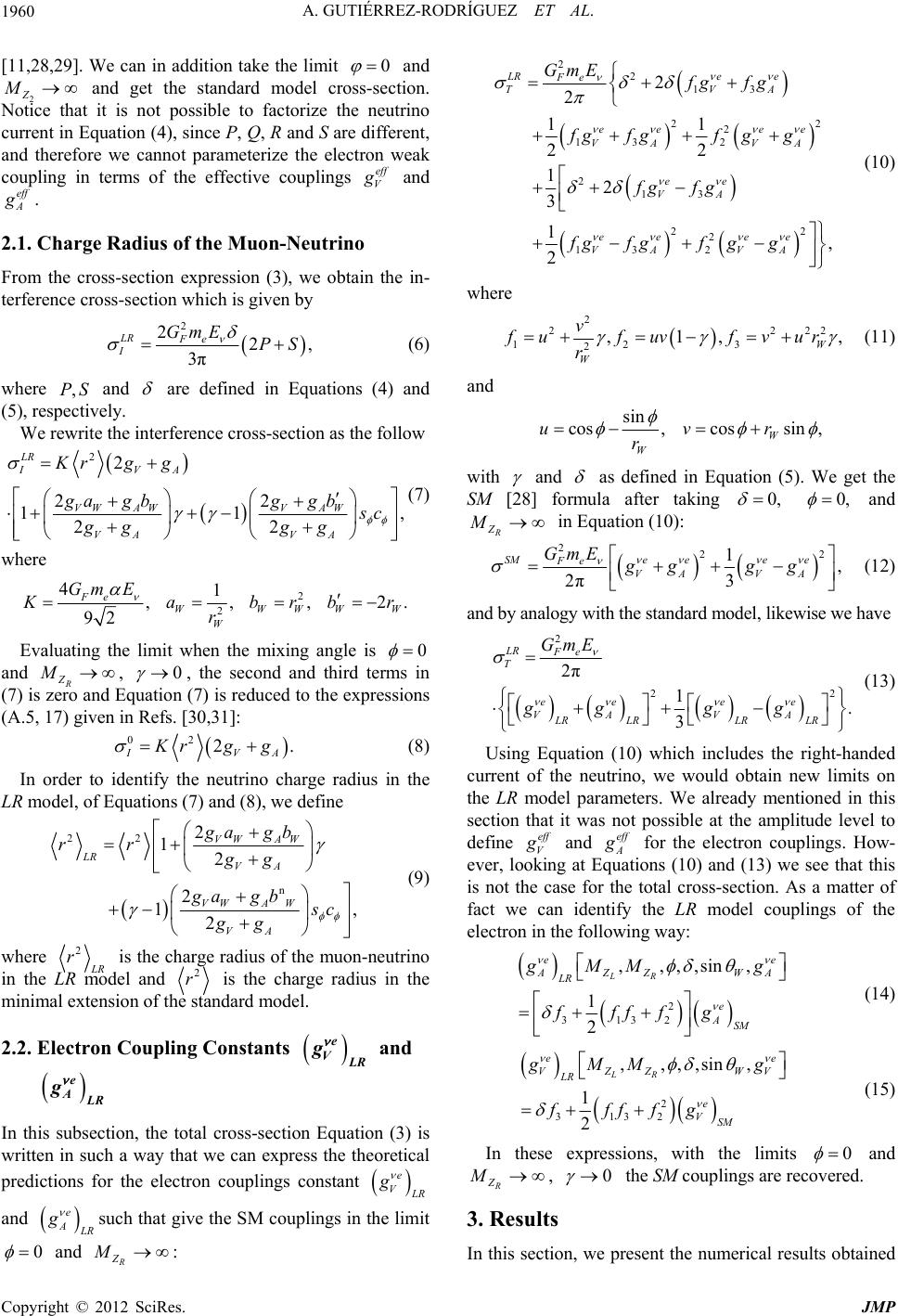 A. GUTIÉRREZ-RODRÍGUEZ ET AL. 1960 [11,28,29]. We can in addition take the limit 0 and 2 Z and get the standard model cross-section. Notice that it is not possible to factorize the neutrino current in Equation (4), since P, Q, R and S are different, and therefore we cannot parameterize the electron weak coupling in terms of the effective couplings M eff V and eff A . 2.1. Charge Radius of the Muon-Neutrino From the cross-section expression (3), we obtain the in- terference cross-section which is given by , E ,PS 2 2 3π LR Fe I Gm 2PS (6) where and are defined in Equations (4) and (5), respectively. We rewrite the interference cross-section as the follow 22 11, LR IVA VW AWAW VA VA Krg g ga gbgb22 22 V g c gg gg (7) where 4, 92 Fe Gm E K 2, W , WW br 1 W ar 22. WW br 0 Evaluating the limit when the mixing angle is and R Z, M 0 , the second and third terms in (7) is zero and Equation (7) is reduced to the expressions (A.5, 17) given in Refs. [30,31]: 2 IVA 02 . rgg (8) In order to identify the neutrino charge radius in the LR model, of Equations (7) and (8), we define 22 2 12 2 1 2 VW LR VW ga rr gagn , AW VA A W VA gb gg b c gg (9) where 2 R is the charge radius of the muon-neutrino in the LR model and r2 r is the charge radius in the minimal extension of the standard model. 2.2. Electron Coupling Constants e V R g and e A R g In this subsection, the total cross-section Equation (3) is written in such a way that we can express the theoretical predictions for the electron couplings constant e V R g e A and R g such that give the SM couplings in the limit 0 and : R Z M 2 2 13 22 2 13 2 2 13 22 2 13 2 2 2 11 22 12 3 1, 2 LRe e Fe TVA ee ee VA VA ee VA ee ee VA VA GmE fg fg fgfgf gg fg fg fgfgfgg (10) where 2 2222 123 2,1, , W W v ufuvfvur r (11) and sin cos , W ur cossin , W vr and with as defined in Equation (5). We get the SM [28] formula after taking 0, 0, and in Equation (10): R Z M 222 1, 2π3 SMe ee e Fe VA VA GmE gg gg (12) and by analogy with the standard model, likewise we have 2 22 2π 1. 3 LR Fe T ee ee VA VA LR LRLR LR GmE gg gg (13) eff Using Equation (10) which includes the right-handed current of the neutrino, we would obtain new limits on the LR model parameters. We already mentioned in this section that it was not possible at the amplitude level to define V and A eff for the electron couplings. How- ever, looking at Equations (10) and (13) we see that this is not the case for the total cross-section. As a matter of fact we can identify the LR model couplings of the electron in the following way: 2 3132 ,,,,sin, 1 2 LR ee AZZ WA LR e ASM MM g ffffg (14) 2 3132 ,,,,sin, 1 2 LR ee VZZ WV LR e VSM MM g ffffg 0 (15) In these expressions, with the limits and , R Z M 0 the SM couplings are recovered. 3. Results In this section, we present the numerical results obtained Copyright © 2012 SciRes. JMP 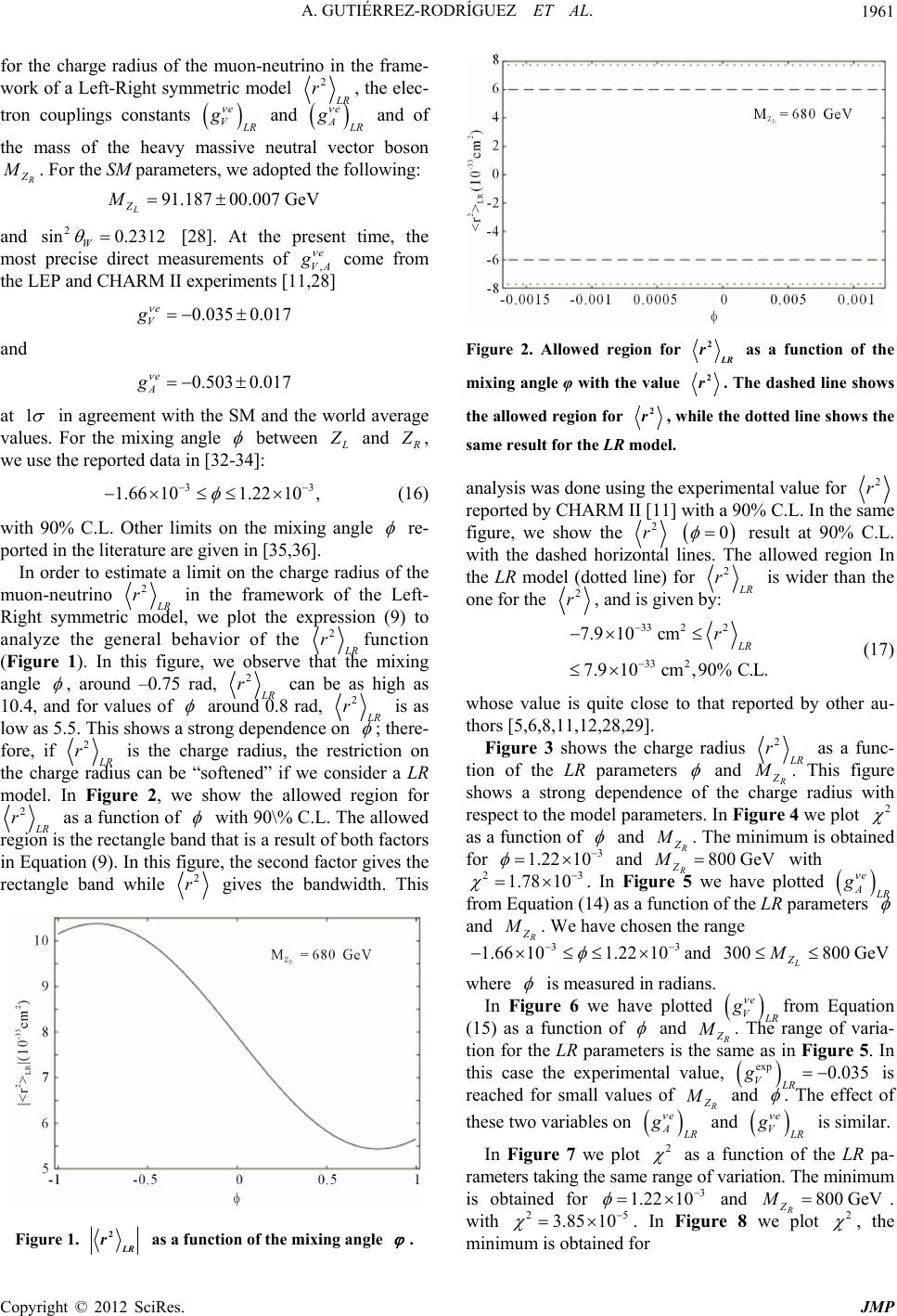 A. GUTIÉRREZ-RODRÍGUEZ ET AL. 1961 for the charge radius of the muon-neutrino in the frame- work of a Left-Right symmetric model 2 R r, the elec- tron couplings constants e e AV R g and R g and of the mass of the heavy massive neutral vector boson . For the SM parameters, we adopted the following: 91.187 L Z M00.007 GeV 0.2312 e and W [28]. At the present time, the most precise direct measurements of ,VA 2 sin 0.035 0.017 0.5030.017 1 come from the LEP and CHARM II experiments [11,28] e V g and 2 LR rFigure 2. Allowed region for as a function of the mixing angle φ with the value e A g 2 r. The dashed line shows the allowed region for at in agreement with the SM and the world average values. For the mixing angle between 2 r, while the dotted line shows the same result for the LR model. and , we use the reported data in [32-34]: 2 r analysis was done using the experimental value for reported by CHARM II [11] with a 90% C.L. In the same figure, we show the 33 1.22 10, 1.66 10 (16) with 90% C.L. Other limits on the mixing angle re- ported in the literature are given in [35,36]. 2 r 0 result at 90% C.L. with the dashed horizontal lines. The allowed region In the LR model (dotted line) for In order to estimate a limit on the charge radius of the muon-neutrino 2 2 R in the framework of the Left- Right symmetric model, we plot the expression (9) to analyze the general behavior of the r R r is wider than the one for the 2 r, and is given by: 33 22 33 2 7.9 10cm 7.910cm,90% C.L. LR r 2 Rfunction (Figure 1). In this figure, we observe that the mixing angle r , around –0.75 rad, 2 R can be as high as 10.4, and for values of (17) rwhose value is quite close to that reported by other au- thors [5,6,8,11,12,28,29]. 2 around 0.8 rad, R is as low as 5.5. This shows a strong dependence on r ; there- fore, if 2 R is the charge radius, the restriction on the charge radius can be “softened” if we consider a LR model. In Figure 2, we show the allowed region for 2 Figure 3 shows the charge radius R as a func- tion of the LR parameters r r and . This figure shows a strong dependence of the charge radius with respect to the model parameters. In Figure 4 we plot 2 as a function of 2 r R as a function of with 90\% C.L. The allowed region is the rectangle band that is a result of both factors in Equation (9). In this figure, the second factor gives the rectangle band while and . The minimum is obtained for 3 1.22 10 800 GeV 23 1.78 10 and R Z M with e A . In Figure 5 we have plotted 2 r gives the bandwidth. This R g from Equation (14) as a function of the LR parameters and . We have chosen the range 33 1.66 101.22 10 300800 GeV L Z M and where is measured in radians. In Figure 6 we have plotted V e Rfrom Equation (15) as a function of g and . The range of varia- tion for the LR parameters is the same as in Figure 5. In this case the experimental value, VLR is reached for small values of exp 0.035g and . The effect of e A Figure 1. 2 LR r as a function of the mixing angle . these two variables on R g e V and R g 2 is similar. In Figure 7 we plot as a function of the LR pa- rameters taking the same range of variation. The minimum is obtained for and R Z. with 3 1.22 10 800 GeVM 25 3.85 10 2 . In Figure 8 we plot , the minimum is obtained for Copyright © 2012 SciRes. JMP 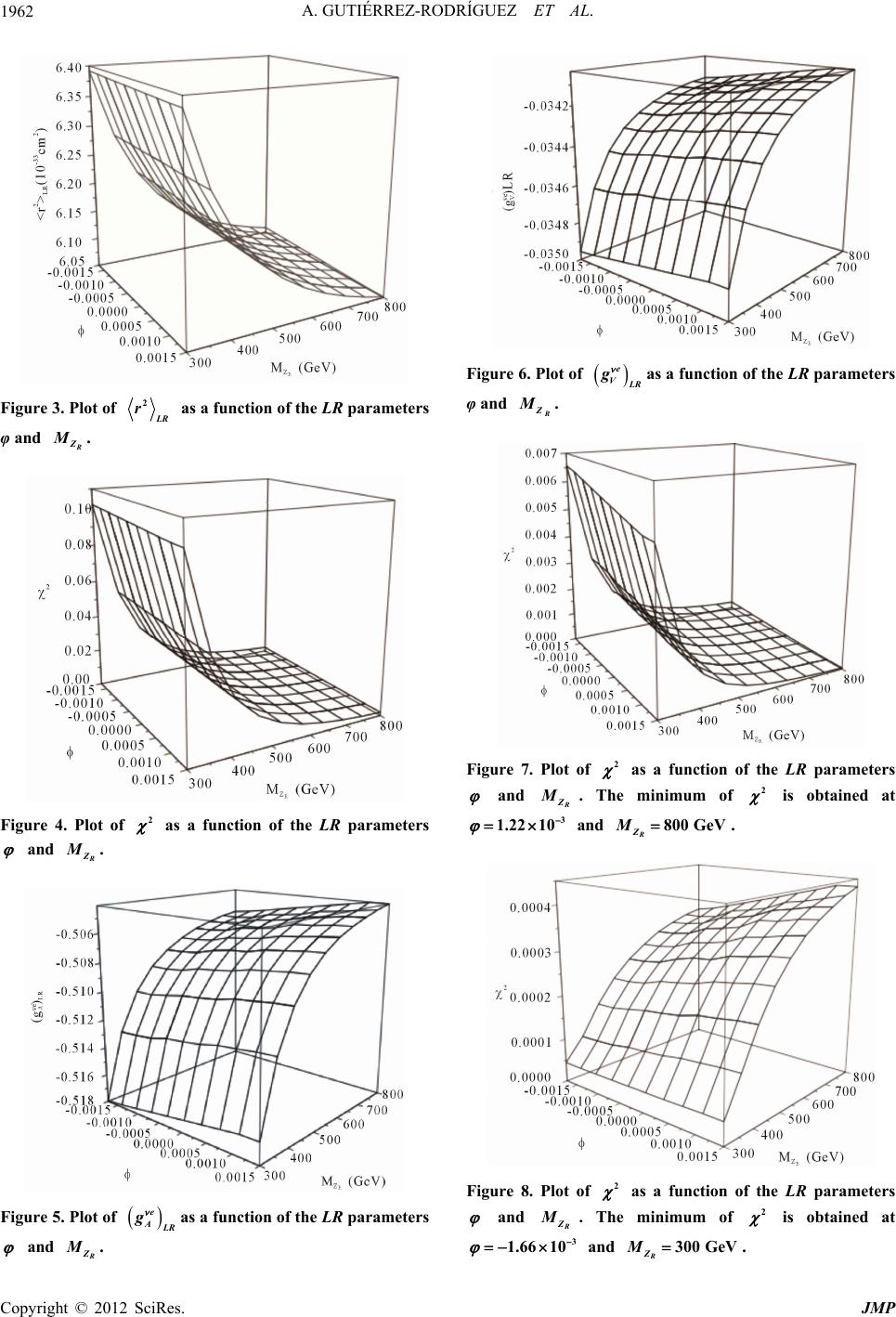 A. GUTIÉRREZ-RODRÍGUEZ ET AL. 1962 Figure 3. Plot of 2 LR r as a function of the LR parameters φ and Z M. Figure 4. Plot of 2 as a function of the LR parameters and Z M. Figure 5. Plot of e ALR g as a function of the LR parameters and Z M. Figure 6. Plot of e VLR g as a function of the LR parameters φ and Z M. Figure 7. Plot of 2 as a function of the LR parameters and Z M2 . The minimum of is obtained at 3 1.22 10 800 GeV R Z M and . Figure 8. Plot of 2 as a function of the LR parameters and Z M2 . The minimum of is obtained at 3 1.66 10 300 GeV R Z M and . Copyright © 2012 SciRes. JMP 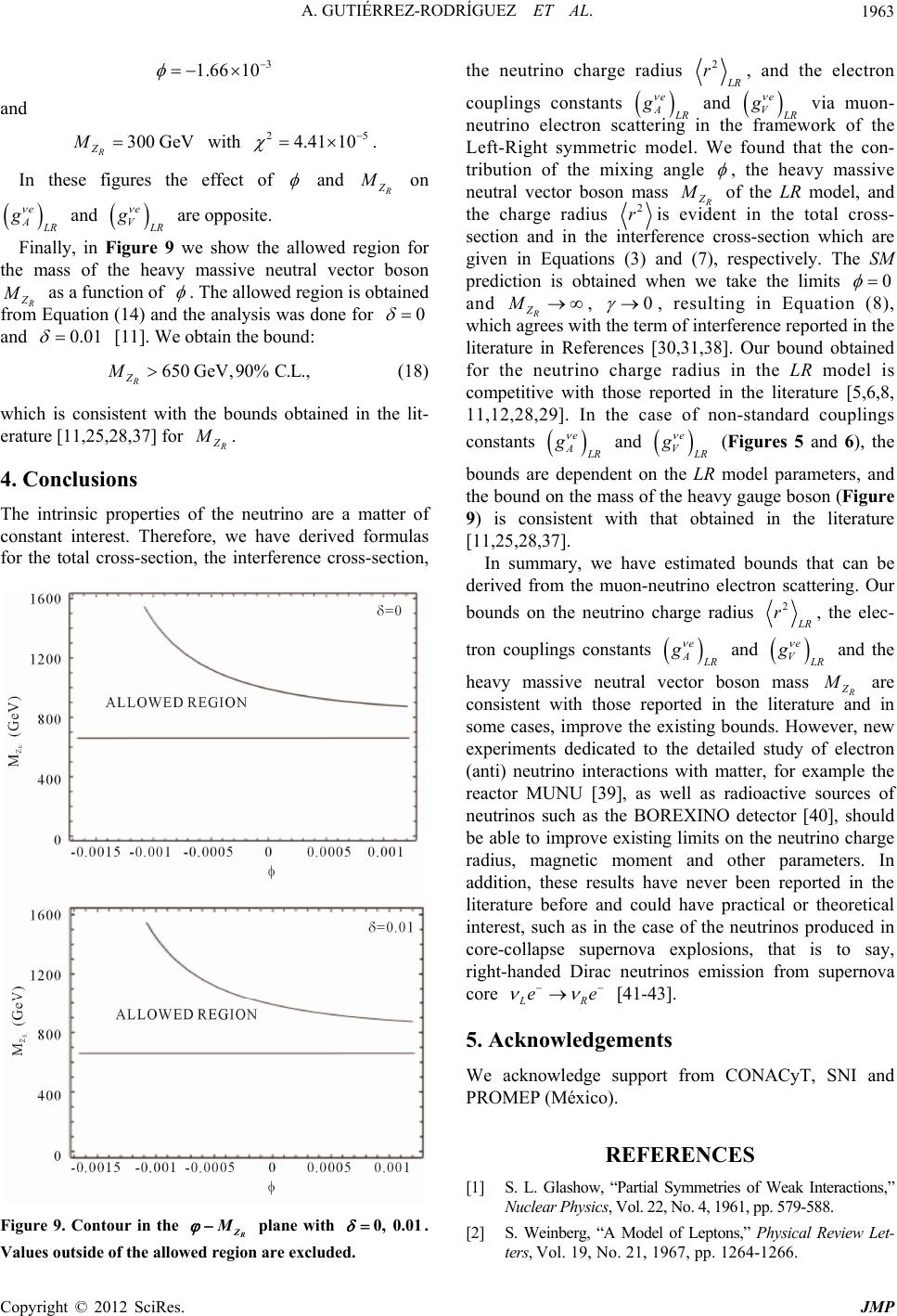 A. GUTIÉRREZ-RODRÍGUEZ ET AL. 1963 3 1.66 10 30 R25 4.41 10 2 and 0 GeV Z M with . In these figures the effect of and on e A R g and e V R g are opposite. Finally, in Figure 9 we show the allowed region for the mass of the heavy massive neutral vector boson as a function of . The allowed region is obtained from Equation (14) and the analysis was done for 0 and 0.01 ,90% C.L., [11]. We obtain the bound: 650 GeV R Z M (18) which is consistent with the bounds obtained in the lit- erature [11,25,28,37] for . 4. Conclusions The intrinsic properties of the neutrino are a matter of constant interest. Therefore, we have derived formulas for the total cross-section, the interference cross-section, Figure 9. Contour in the Z M 0,0.01 plane with . Values outside of the allowed region are excluded. the neutrino charge radius R r, and the electron couplings constants e A R and V g e R via muon- neutrino electron scattering in the framework of the Left-Right symmetric model. We found that the con- tribution of the mixing angle g , the heavy massive neutral vector boson mass of the LR model, and the charge radius 2 r 0 is evident in the total cross- section and in the interference cross-section which are given in Equations (3) and (7), respectively. The SM prediction is obtained when we take the limits and R Z, M 0 , resulting in Equation (8), which agrees with the term of interference reported in the literature in References [30,31,38]. Our bound obtained for the neutrino charge radius in the LR model is competitive with those reported in the literature [5,6,8, 11,12,28,29]. In the case of non-standard couplings e A e V constants R g and R g (Figures 5 and 6), the bounds are dependent on the LR model parameters, and the bound on the mass of the heavy gauge boson (Figure 9) is consistent with that obtained in the literature [11,25,28,37]. In summary, we have estimated bounds that can be derived from the muon-neutrino electron scattering. Our 2 bounds on the neutrino charge radius R r, the elec- e A tron couplings constants R g e V and R g and the heavy massive neutral vector boson mass are consistent with those reported in the literature and in some cases, improve the existing bounds. However, new experiments dedicated to the detailed study of electron (anti) neutrino interactions with matter, for example the reactor MUNU [39], as well as radioactive sources of neutrinos such as the BOREXINO detector [40], should be able to improve existing limits on the neutrino charge radius, magnetic moment and other parameters. In addition, these results have never been reported in the literature before and could have practical or theoretical interest, such as in the case of the neutrinos produced in core-collapse supernova explosions, that is to say, right-handed Dirac neutrinos emission from supernova core LR ee [41-43]. 5. Acknowledgements We acknowledge support from CONACyT, SNI and PROMEP (México). REFERENCES [1] S. L. Glashow, “Partial Symmetries of Weak Interactions,” Nuclear Ph ysics , Vol. 22, No. 4, 1961, pp. 579-588. [2] S. Weinberg, “A Model of Leptons,” Physical Review Let- ters, Vol. 19, No. 21, 1967, pp. 1264-1266. Copyright © 2012 SciRes. JMP  A. GUTIÉRREZ-RODRÍGUEZ ET AL. 1964 [3] N. Svartholm, “Elementary Particle Theory,” Almqvist and Wiskell, Stockholm, 1968. [4] B. Kayser, “Majorana Neutrinos and their Electromagnetic Properties,” Physical Review D, Vol. 26, No. 11, 1982, pp. 1662-1670. doi:10.1103/PhysRevD.26.1662 [5] G. Degrassi, A. Sirlin and W. J. Marciano, “Effective Electromagnetic Form-Factor of the Neutrino,” Physical Review D, Vol. 39, No. 1, 1989, pp. 287-294. doi:10.1103/PhysRevD.39.287 [6] J. L. Lucio, A. Rosado and A. Zepeda, “A Characteristic Size for the Neutrino,” Physical Review D, Vol. 31, No. 5, 1985, pp. 1091-1096. doi:10.1103/PhysRevD.31.1091 [7] C. Giunti and A. Studenikin, “Neutrino Electromagnetic Properties,” Physics of Atomic Nuclei, Vol. 72, No. 12, 2009, pp. 2089-2125. doi:10.1134/S1063778809120126 [8] K. J. F. Gaemers, R. Gandhi and J. M. Lattimer, “Neu- trino Helicity Flips via Electroweak Interactions and SN1987a,” Physical Review D, Vol. 40, No. 5, 1989, pp. 309-314. doi:10.1103/PhysRevD.40.309 [9] R. C. Allen, H. H. Chen, P. J. Doe, R. Hausammann, W. P. Lee, X. Q. Lu, H. J. Mahler and M. E. Potter, “Study of Electron-Neutrino Electron Elastic Scattering at LAMPF,” Physical Revi ew D, Vol. 47, No. 1, 1993, pp. 11-28. doi:10.1103/PhysRevD.47.11 [10] L. B. Auerbach, et al., “Measurement of Electron-Neutrino and Electron Elastic Scattering,” Physical Review D, Vol. 63, 2001, Article ID: 112001. doi:10.1103/PhysRevD.63.112001 [11] P. Vilain, et al., “Experimental Study of Electromagnetic Properties of the Muon-Neutrino in Neutrino-Electron Scattering,” Physics Letters B, Vol. 345, No. 1, 1995, pp. 115-118. doi:10.1016/0370-2693(94)01678-6 [12] A. S. Joshipura and S. Mohanty, “Bounds on Tau Neutrino Magnetic Moment and Charge Radius from Super-K and SNO Observations,” arXiv:hep-ph/0108018. [13] T. Toshito, “Super-Kamiokande Atmospheric Neutrino Results,” arXiv:hep-ex/0105023. [14] A. D. Dolgov, “Neutrinos in Cosmology,” Physics Reports, Vol. 370, No. 4-5, 2002, pp. 333-535. doi:10.1016/S0370-1573(02)00139-4 [15] R. N. Mohapatra and P. B. Pal, “Massive Neutrinos in Physics and Astrophysics,” 3rd Edition, World Scientific, Singapore City, 2004. doi:10.1142/9789812562203 [16] A. Cisneros, “Effect of Neutrino Magnetic Moment on Solar Neutrino Observations,” Astrophysics and Space Science, Vol. 10, No. 10, 1971, pp. 87-92. doi:10.1007/BF00654607 [17] J. Pulido, “Solar Neutrinos with Magnetic Moment: Rates and Global Analysis,” Astroparticle Physics, Vol. 18, No. 2, 2002, pp. 173-181. doi:10.1016/S0927-6505(02)00106-8 [18] J. Pulido and E. K. Akhmedov, “Resonance Spin Flavor Precession and Solar Neutrinos,” Astroparticle Physics, Vol. 13, No. 2-3, 2000, pp. 227-244. doi:10.1016/S0927-6505(99)00121-8 [19] M. M. Guzzo and H. Nunokawa, “Current Status of the Resonant Spin Flavor Precession Solution to the Solar Neutrino Problem,” Astroparticle Physics, Vol. 12, No. 1-2, 1999, pp. 87-95. doi:10.1016/S0927-6505(99)00075-4 [20] W. A. Bardeen, R. Gastmans and B. E. Lautrup, “Static Quantities in Weinberg’s Model of Weak and Electromag- netic Interactions,” Nuclear Physics B, Vol. 46, No. 1, 1972, pp. 319-331. doi:10.1016/0550-3213(72)90218-0 [21] B. W. Lee and R. E. Shrock, “Natural Suppression of Symmetry Violation in Gauge Theories: Muon-Lepton and Electron Lepton Number Non-Conservation,” Physical Re- view D , Vol. 16, No. 5, 1977, pp. 1444-1473. doi:10.1103/PhysRevD.16.1444 [22] J. Bernabeu, J. Papavassiliou and J. Vidal, “On the Ob- servability of the Neutrino Charge Radius,” Physical Re- view Letters, Vol. 89, No. 2002, Article ID: 101802. doi:10.1103/PhysRevLett.89.101802 [23] J. M. Cornwall and J. Papavassiliou, “Gauge Invariant Three-Gluon Vertex in QCD,” Physical Review D, Vol. 40, No. 10, 1989, pp. 3474-3485. doi:10.1103/PhysRevD.40.3474 [24] J. C. Pati and A. Salam, “Lepton Number as the Fourth Color,” Physical Review D, Vol. 10, No. 1, 1974, pp. 275- 289. doi:10.1103/PhysRevD.10.275 [25] M. Czakon, J. Gluza and M. Zralek, “Low-Energy Physics and Left-Right Symmetry: Bounds and the Model Pa- rameters,” Physics Letters B, Vol. 458, No. 2-3, 1999, pp. 355-360. doi:10.1016/S0370-2693(99)00567-5 [26] G. C. Branco and J. Liu, “More on the Neutrino Magnetic Moment in Left-Right Models,” Physics Letters B, Vol. 210, No. 1-2, 1988, pp. 164-168. doi:10.1016/0370-2693(88)90366-8 [27] V, Cerón, M. Maya and O. G. Miranda, “Particles and Fields,” World Scientific, Singapore City, 1994. [28] Particle Data Group, C. Amsler, et al., “Review of Parti- cle Physics,” Physics Letters B, Vol. 667, No. 1-5, 2008, p. 1 [29] M. Hirsch, E. Nardi and D. Restrepo, “Bounds on the Tau and Muon Neutrino Vector and Axial Vector Charge Ra- dius,” Physical Review D, Vol. 67, No. 3, 2003, Article ID: 033005. doi:10.1103/PhysRevD.67.033005 [30] P. Vogel and J. Engel, “Neutrino Electromagnetic Form- Factors,” Physical Review D, Vol. 39, No. 11, 1989, pp. 3378-3383. doi:10.1103/PhysRevD.39.3378 [31] J. Dorenbosch, et al., “Experimental Results on Neutrino- Electron Scattering,” Zeitschrift für Physik C: Particles and Fields, Vol. 41, No. 4, 1989, pp. 567-589. doi:10.1007/BF01564701 [32] A. Gutierrez-Rodriguez, M. A. Hernandez-Ruiz and M. A. Perez, “Limits on the Electromagnetic and Weak Dipole Moments of the Tau-Lepton in E(6) Superstring Models,” International Journal of Modern Physics A, Vol. 22, No. 20, 2007, p. 3493. [33] A. Gutierrez-Rodriguez, M. A. Hernandez-Ruiz, M. A. Perez and F. Perez-Vargas, “Bounding the Number of Light Neu- trinos Species in a Left-Right Symmetric Model,” hep-ph/ 0702076. [34] A. Gutierrez-Rodriguez, M. A. Hernandez-Ruiz, M. A. Perez and F. Perez-Vargas, “Constraints on Left-Right Symmetric and E(6) Superstring Models from the Num- Copyright © 2012 SciRes. JMP 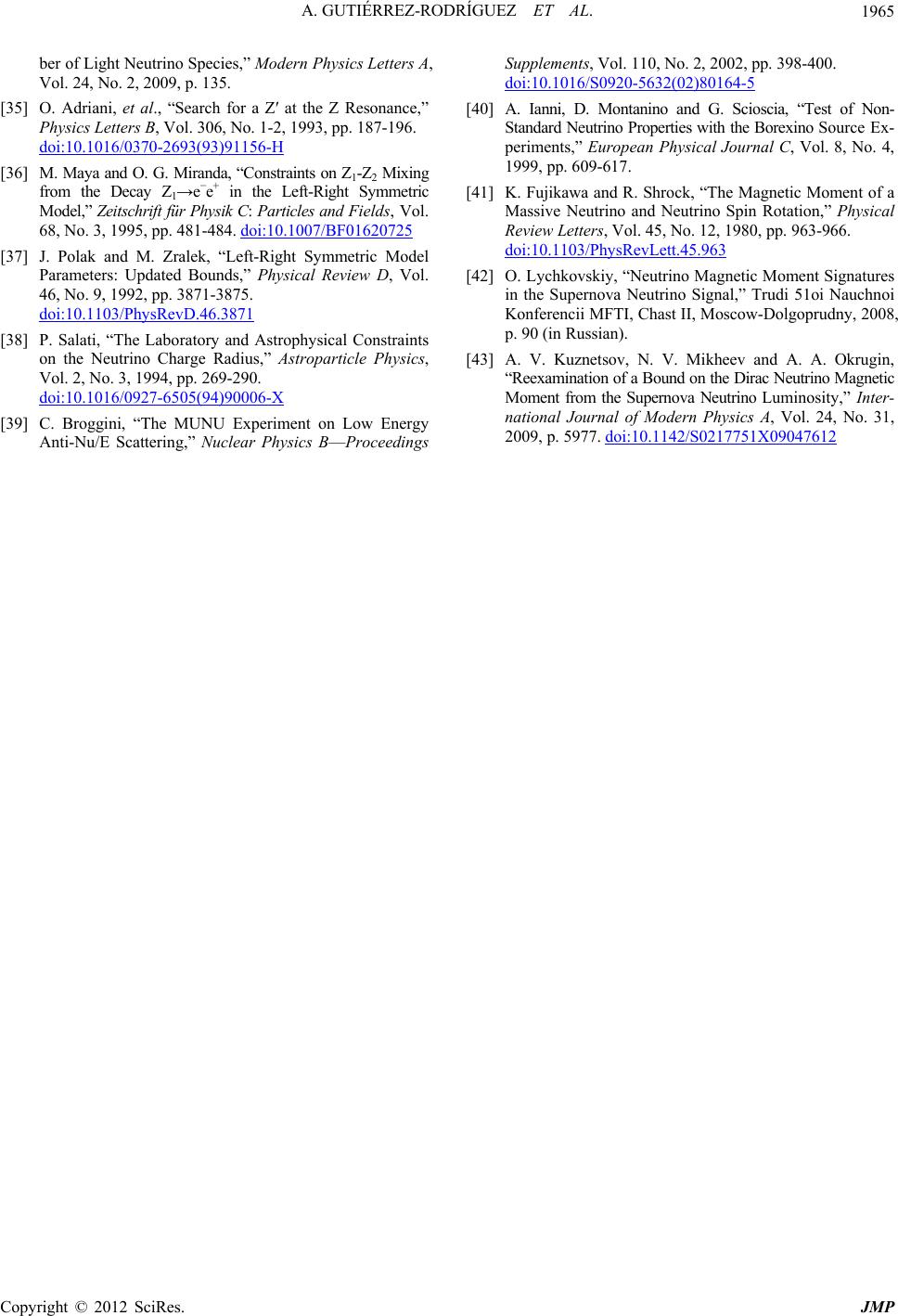 A. GUTIÉRREZ-RODRÍGUEZ ET AL. Copyright © 2012 SciRes. JMP 1965 ber of Light Neutrino Species,” Modern Physics Letters A, Vol. 24, No. 2, 2009, p. 135. [35] O. Adriani, et al., “Search for a Z′ at the Z Resonance,” Physics Letters B, Vol. 306, No. 1-2, 1993, pp. 187-196. doi:10.1016/0370-2693(93)91156-H [36] M. Maya and O. G. Miranda, “Constraints on Z1-Z2 Mixing from the Decay Z1→e−e+ in the Left-Right Symmetric Model,” Zeitschrift für Physik C: Particles a nd Fi el d s, Vol. 68, No. 3, 1995, pp. 481-484. doi:10.1007/BF01620725 [37] J. Polak and M. Zralek, “Left-Right Symmetric Model Parameters: Updated Bounds,” Physical Review D, Vol. 46, No. 9, 1992, pp. 3871-3875. doi:10.1103/PhysRevD.46.3871 [38] P. Salati, “The Laboratory and Astrophysical Constraints on the Neutrino Charge Radius,” Astroparticle Physics, Vol. 2, No. 3, 1994, pp. 269-290. doi:10.1016/0927-6505(94)90006-X [39] C. Broggini, “The MUNU Experiment on Low Energy Anti-Nu/E Scattering,” Nuclear Physics B—Proceedings Supplements, Vol. 110, No. 2, 2002, pp. 398-400. doi:10.1016/S0920-5632(02)80164-5 [40] A. Ianni, D. Montanino and G. Scioscia, “Test of Non- Standard Neutrino Properties with the Borexino Source Ex- periments,” European Physical Journal C, Vol. 8, No. 4, 1999, pp. 609-617. [41] K. Fujikawa and R. Shrock, “The Magnetic Moment of a Massive Neutrino and Neutrino Spin Rotation,” Physical Review Letters, Vol. 45, No. 12, 1980, pp. 963-966. doi:10.1103/PhysRevLett.45.963 [42] O. Lychkovskiy, “Neutrino Magnetic Moment Signatures in the Supernova Neutrino Signal,” Trudi 51oi Nauchnoi Konferencii MFTI, Chast II, Moscow-Dolgoprudny, 2008, p. 90 (in Russian). [43] A. V. Kuznetsov, N. V. Mikheev and A. A. Okrugin, “Reexamination of a Bound on the Dirac Neutrino Magnetic Moment from the Supernova Neutrino Luminosity,” Inter- national Journal of Modern Physics A, Vol. 24, No. 31, 2009, p. 5977. doi:10.1142/S0217751X09047612
|